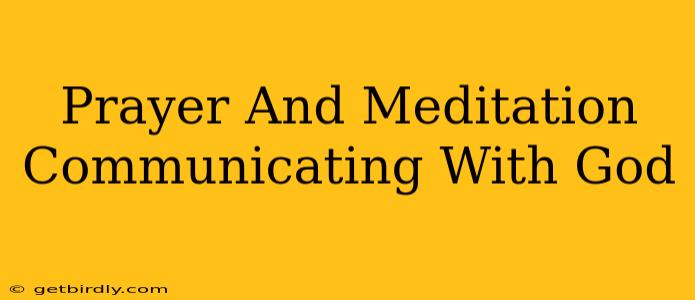Prayer and Meditation: Communicating with God
Prayer and meditation are two distinct yet interconnected spiritual practices used by people across numerous faiths to connect with the divine. While often used interchangeably, understanding their subtle differences can enrich your spiritual journey and deepen your communication with God (or the Higher Power you believe in). This article explores the nuances of prayer and meditation, examining their individual benefits and how they complement each other in fostering a profound spiritual connection.
What is Prayer?
Prayer, in its simplest form, is a conversation with God. It's a direct form of communication, often involving supplication, thanksgiving, confession, or intercession. Prayer can be vocalized, whispered, or even silent, taking many forms depending on individual beliefs and traditions. Some common types of prayer include:
- Petitionary Prayer: Asking God for something – healing, guidance, strength, or material blessings.
- Intercessory Prayer: Praying for others, seeking God's intervention on their behalf.
- Confessional Prayer: Admitting shortcomings and seeking forgiveness.
- Thanksgiving Prayer: Expressing gratitude for blessings received.
- Adoration Prayer: Focusing on the majesty and glory of God.
- Contemplative Prayer: A quieter, more reflective form of prayer, focusing on presence with God rather than specific requests.
What is Meditation?
Meditation, unlike prayer, isn't necessarily a direct conversation with God. Instead, it's a practice of cultivating inner stillness and awareness. It involves focusing on a single point of attention – a mantra, breath, or image – to quiet the mind and connect with a deeper level of consciousness. The goal isn't to ask for things but to cultivate inner peace, self-awareness, and a heightened sense of connection to something larger than oneself. Different meditation techniques include:
- Mindfulness Meditation: Paying attention to the present moment without judgment.
- Transcendental Meditation: Using a mantra to quiet the mind.
- Walking Meditation: Focusing on the physical sensations of walking.
- Guided Meditation: Following a guided script or audio recording.
How Do Prayer and Meditation Work Together?
While distinct, prayer and meditation synergistically enhance spiritual growth. Meditation can prepare the mind for prayer by creating a space of stillness and receptivity. A calm, focused mind is better able to connect with the divine and receive guidance or inspiration. Conversely, prayer can deepen the meditative experience by providing a framework for reflection and contemplation. The quiet space created through meditation allows for a more profound and meaningful prayer experience.
What are the Benefits of Prayer and Meditation?
The benefits of incorporating prayer and meditation into your life are numerous and extend beyond the purely spiritual:
- Reduced Stress and Anxiety: Both practices have been shown to lower cortisol levels, reducing stress and promoting relaxation.
- Improved Mental Clarity: Quietening the mind through meditation enhances focus and concentration.
- Increased Self-Awareness: Meditation helps individuals become more aware of their thoughts, emotions, and behaviors.
- Spiritual Growth: Both practices foster a deeper connection with the divine and a sense of purpose.
- Emotional Regulation: Prayer and meditation can provide solace and comfort during difficult times, fostering emotional resilience.
How Can I Incorporate Prayer and Meditation into My Daily Life?
Starting a daily practice of prayer and meditation doesn't require a grand commitment. Begin with just a few minutes each day and gradually increase the time as you feel comfortable. Find a quiet space where you won't be disturbed. Experiment with different techniques to find what resonates with you. Consistency is key – even short, regular sessions are more beneficial than infrequent, longer ones.
How Can Prayer Help Me Communicate With God?
Prayer facilitates communication with God by allowing you to express your thoughts, feelings, and needs directly. It’s a way to build a relationship with the divine through dialogue, gratitude, and seeking guidance. Remember, effective communication involves both speaking and listening – be open to receiving answers through intuition, inspiration, or unexpected events.
What are the Different Types of Meditation for Connecting With God?
Many types of meditation can facilitate a connection with God. Centering prayer, for example, involves repeating a sacred word or phrase to quiet the mind and open the heart to God's presence. Mindfulness meditation can also be adapted to focus on God's presence in the present moment. The key is finding a method that resonates with your beliefs and preferences.
Conclusion
Prayer and meditation are powerful tools for fostering a meaningful relationship with God. By understanding their individual strengths and how they complement each other, you can cultivate a deeper spiritual connection and enrich your life. Remember, the most important aspect is consistency and intention – approaching these practices with an open heart and a desire for connection. The journey of communication with God is a personal one, so explore different methods and find what works best for you.

